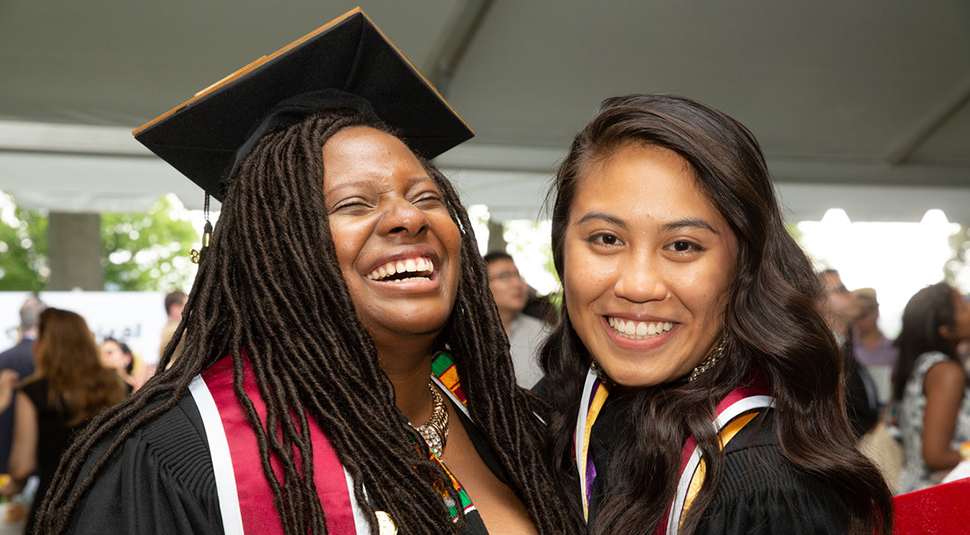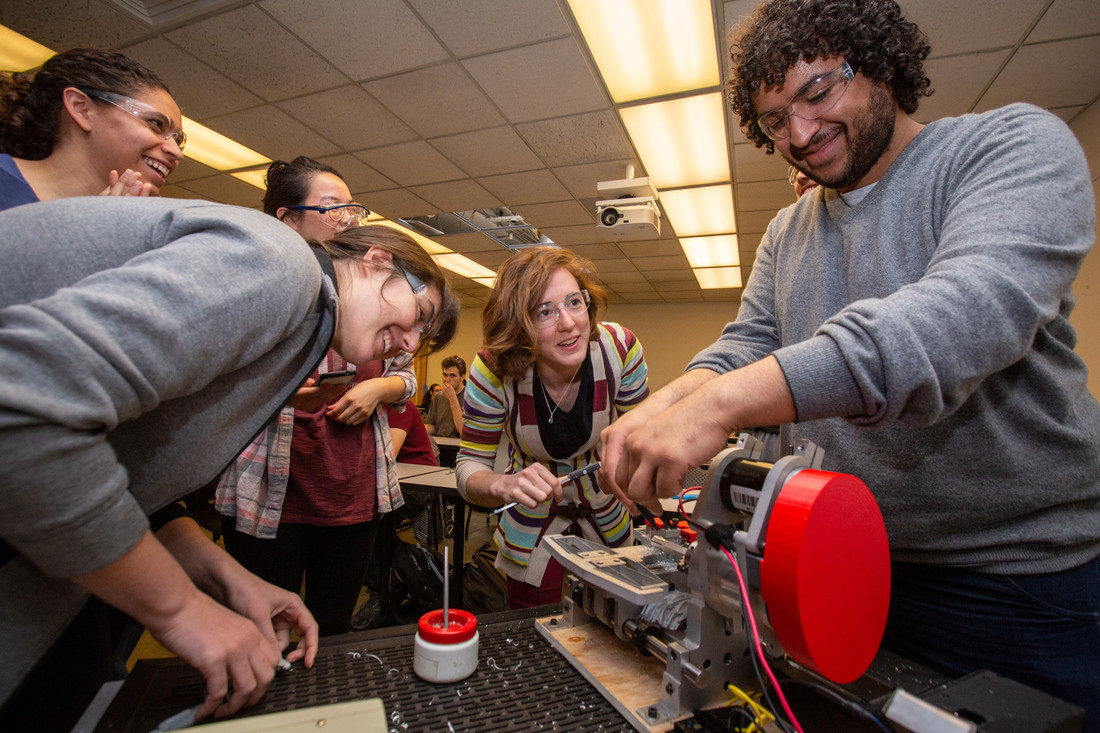Our Vision
As part of its mission to make the world a better place, the MIT Mechanical Engineering Department (MechE) aims to solve global challenges by training the next generation of mechanical engineering leaders.1 We know inclusive diversity is central to this mission, which is why our community is built on a culture that prioritizes people. In addition to providing a world-class engineering education, our curriculum includes a robust examination of the historical, ethical, and social contexts of engineering to ensure our graduates are conscious contributors to their professions. Internally, we incorporate these values into the research we produce and give them substantial weight in faculty hiring and promotion decisions. Systemic injustice has historically excluded certain groups from academia and the fields of science, technology, engineering and mathematics (STEM). Our department leverages MIT’s resources to attract and support talented individuals. Once people arrive in MechE, we welcome them to our community through comprehensive orientations and open communication. One critically important aspect of any leadership position in our community is the responsibility to support others in their personal and professional growth. We promote a culture of teamwork and respect by acknowledging the value that each person brings to our collective efforts to advance science and engineering, and by acknowledging that prioritizing health is essential to personal productivity. For these reasons, all of our faculty and senior staff have extensive management and mentorship training as well as detailed knowledge of the many support resources available at MIT. These aspects of our community enable us to foster a diverse and inclusive environment, focusing on what makes MIT MechE truly special: the people.
Where We Are Now
MIT as a whole is committed to creating a workplace and educational environment that welcomes and supports people of diverse backgrounds and celebrates differences in race, gender, ethnicity, nationality, age, physical and language abilities, culture, religion, and sexual orientation.2 Despite this goal, there is a lack of diversity at MIT and in MechE. The above vision statement for our department has not yet been fully realized. We strive to make it a reality.
In light of the recent surge in national recognition of anti-Black racism in the United States and globally, we can start by examining diversity along the axis of race and ethnicity. MIT defines an underrepresented minority (URM) as an individual who is Black, Indigenous, or Hispanic/Latinx; this is a domestic term that pertains specifically to the United States and Native American nations. As of 2020, the MechE domestic graduate and undergraduate student population is 21.7% URM and 66.9% non-URM, the faculty are 8.7% URM and 85.5% non-URM, the staff are 7.6% URM and 66.5% non-URM, and the postdoc population is 3.8% URM and 76.9% non-URM.3 Most of these demographics do not reflect the demographics of the United States, which, according to MIT’s definition, is 33.4% URM and 66% non-URM.4 It is also noteworthy that the MechE international student population is approximately 16.9% European and 1.8% African, and the postdoc population is approximately 76% from Asia and the Pacific, 4.3% from the Americas, and 0% African.5 These populations are significantly different from the world’s population for Asia and the Pacific (60%), Africa (17.2%), Europe (9.6%), and the Americas, not including the United States (12%).6
Systemic racism, which is codified racial discrimination at every level of society, is pervasive in all institutions in the United States. It is the legacy of four centuries of slavery in this country, colonialism, and global Eurocentrism. MIT was founded and developed in this context and, as a result, has historically been a predominantly White institution.7 Consequently, URMs, individuals from underrepresented international groups, and in particular Black, Indigenous, and People of Color (BIPOC), will face a unique set of obstacles to their success and wellbeing on this campus.
We must also consider how power structures in academia play a role in establishing and maintaining systemic issues. The power of direction and action in academia rests primarily with the faculty. Tenure, in particular, is designed to provide faculty members with academic immunity, the job security that grants them intellectual freedom as experts in their field. However, the mechanism of tenure can function as moral impunity, shielding tenured faculty from meaningful consequences when they abuse their power or act in a way that contradicts our community values.
Moving Forward
While race, ethnicity, and nationality are concrete starting points for examining institutional diversity, it is important to remember that an individual is the nexus of multiple identities. We must continuously account for this intersectionality by actively uprooting local systems of inequality put in place by racist, sexist, ableist, and other exclusionary ideologies.8,9,10 The faculty must lead by example in upholding these values. It is essential to our vision of a healthy community that the department continually examine the ways in which tenure and other power imbalances in academia harm our community members, and act to modify these structures accordingly. Our strength and position as a world-class institution depends upon our ability to cultivate a diverse, equitable, and inclusive community of students and professionals. A diverse community enables a wealth of ideas and perspectives that enhance our ability to solve global problems. However, diversity alone is insufficient. In an organization that is diverse, but not inclusive, individuals who are part of a minority group are unable to express their whole selves for fear of being embarrassed, ostracized, or otherwise harmed personally or professionally. This silences creativity, stifles innovation, and perpetuates exclusionist solutions. To build a community that is both diverse and inclusive, we must ensure equitable treatment of our community members.
This requires us to dismantle exclusionist policies that are embedded in the foundation of our institution, address existing injustices perpetuated by these policies, and provide resources for individuals to learn and grow. In recognizing the systemic nature of the problem, we acknowledge that this must be a sustained effort to create a culture of attentive curiosity, compassionate action, and self-reflection that will ultimately improve everyone’s experience in the department. This vision statement establishes our commitment to building and fostering a diverse, equitable, and inclusive environment in the MIT Mechanical Engineering Department where everyone in our community can thrive.
Citations
- 1 Mechanical Engineering at MIT
- 2 MIT Human Resources: Diversity, Equity, and Inclusion
- 3 Analysis conducted with data provided by Institutional Research; percentages for “mixed” and “unknown” race/ethnicity are left out of the values presented here.
- 4 US Census Bureau QuickFacts: United States (2019)
- 5 Analysis conducted with data provided by Institutional Research.
- 6 Population by Regions in the World (2020)
- 7 MIT and Slavery | An ongoing undergraduate research project
- 8 Black Graduate Student Association - Follow up on 2015 recommendations
- 9 A Study on the Status of Women Faculty In Science at MIT
- 10 Wheels on Campus: Choosing Academics Over Accommodation

